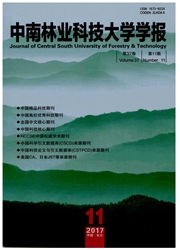

 中文摘要:
中文摘要:
银杏种核中由于含有丰富的营养成分和药理活性的化学成分,已经成为食品、保健品和饮料等工业产品的重要原料,银杏果用林的定向培育能够为以银杏果为原料的各种加工业提供优质的原料。本研究依据银杏果用林培育原理及已有的研究成果,系统总结了银杏果用林的定向培育关键技术,集成了银杏果用林定向培育技术体系:(1)立地控制,要求选择排水良好、土层深厚肥沃、土壤p H值5.5~7.5的适生丰产区内的造林地;(2)品种选择,选用经过选育并获得新品种权或通过林木品种审定委员会审定的果用优良品种;(3)密度调控,根据不同的立地及栽培条件,栽植密度控制在400~500株/hm^2;(4)复合经营,采用复合经营技术提高产量和质量,增加综合效益;(5)施肥以有机肥为主,依据土壤营养诊断追施N、K、P和微量元素肥料;(6)使用嫁接大苗造林。
 英文摘要:
英文摘要:
Nut of Ginkgo bilaba L. is an important material on the production of food, health products and beberage, in which there exsited rich chemical compositions of nutrients and pharmacological activity. And the oriented cultivation of ginkgo nut-harvesting plantaion can supply high quality materials for these industries. Based on the cultivating mechanisms and results of scientific research and practice, some key techniques for cultivating nut-harvesting G. biloba plantation were summarized systematically. The results were as follows: (1) Choosing good sites being suitable for ginkgo growing; (2) Selecting the selected and obtained new species authorization ginkgo varieties or clones from various cultivation zones as the cultivated fruit varieties according to their nut yield and quality; (3) Adopting reasonable planting density, suggested density is from 400 to 500 trees/hm2 according to site condition and cultivating condition; (4) Using agroforestry systems to get higher yield and quality and maintain sustainable land management; (5) Organic fertilizer is advocated in nut-harvesting plantation, at the same time, N, P, K and microelement fertilizer were added according to the results of nutrient diagnosis. (6) Using bigger grafting seedlings to establish nut-harvest ginkgo plantation.
 同期刊论文项目
同期刊论文项目
 同项目期刊论文
同项目期刊论文
 期刊信息
期刊信息
